Fittings for steel pipes: types, classification, marking and installation examples
The arrangement of utilities with the laying of a steel pipeline of various configurations cannot be performed without the use of connection parts.
Before proceeding with the calculation of the system and its assembly, it is necessary to understand what fittings for steel pipes the modern market offers and how are parts assembled, do you agree?
We have prepared a detailed overview of pipe fittings to perform detachable connections, provided recommendations for the selection of elements, and also described the specifics of their application. Step-by-step installation instructions for a threaded fitting and crimp sleeve will help to assemble the pipeline without the involvement of specialists.
The content of the article:
Options for execution of connection parts
Butt connection steel pipe carried out in two ways: detachable and one-piece. The first involves the use of fittings, the second - the welding of parts.
The material for the manufacture of connecting elements is most often stainless steel or ferrous metal. From non-ferrous metals: brass or copper.
The connecting elements can be simply steel or coated with a chrome composition. Chrome products are more preferred in that they have higher anti-corrosion properties.
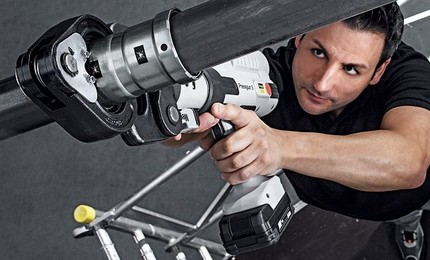
Although experts do not advise using fittings from materials other than those used in the manufacture of pipes, but this is still allowed. So brass fittings are great for copper pipe fittings. Copper can safely connect pipes made of any type of material. Reliability of the connection will not be affected.
The main thing is to avoid the combination of joining of copper elements with bends of unalloyed galvanized steel. In the interaction of these two metals, corrosion processes are instantly launched, adversely affecting the durability of the products.
Fittings on the market in form and purpose are of several options:
- Couplings - elements installed in straight sections for joining pipes of equal diameter.
- Tees - structures with three exits that change the direction of the pipeline and create a branch from the main branch in one direction.
- Crosses - structures with four outputs divide the flow into several "beams", providing a branch from the main highway in perpendicular directions.
- Adapters - are intended for joining of elements having different diameters.
- Fittings - engage, if necessary, docking the rigid pipe with a flexible hose.
- Stubs - use, if necessary, tight sealing of the ends of the pipes.
To change the direction of the pipeline within 45-90 ° both squares and verticals are installed squares.
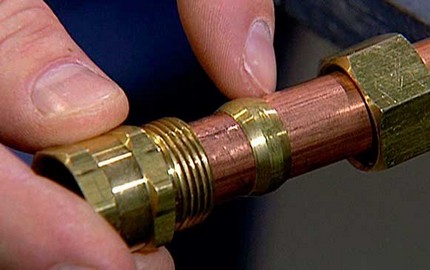
The size range of nominal bore produced by manufacturers of fittings is quite wide and varies from 8 to 125 mm.
The specifics of the use of pipe fittings:
- products D 16-63 mm use where the pressure does not reach 16 atmospheres;
- fittings D 75-125 mm used for pipelines, where the pressure is 10 atmospheres.
All sizes of metal tubular products comply with current GOST 8996-75. According to this normative document, the production of couplings having an internal diameter of 150 mm is also allowed on an individual order.
If the pipe size is indicated in inches, then this indicates the value of the outer diameter. If in other units of measurement - millimeters, then this is an indicator of the internal section of the product.
An important point! Regardless of the design, when purchasing fittings, you should pay attention to the fact that both the outer and inner surfaces do not have any sinks and foreign inclusions. The end planes of the connecting elements must be strictly at right angles to the axes of the passages.
The main types of fittings
Depending on the connection method with the metal pipe, there are several types of fittings: welded, crimped, threaded and flanged. Each of them has its own advantages and disadvantages.
Weld-on couplings
Welded fittings, referred to as segment fittings, are among non-separable elements. They must not be dismantled or reused. Segment parts are used for pipelines operating at temperatures from -70 ° C to + 450 ° C with a working pressure of the system within 16 MPa.
The main difference between such products is that their ends have a smooth surface. The principle of selection is based only on the identity of the characteristics and dimensions of the joined pipes and connecting elements.
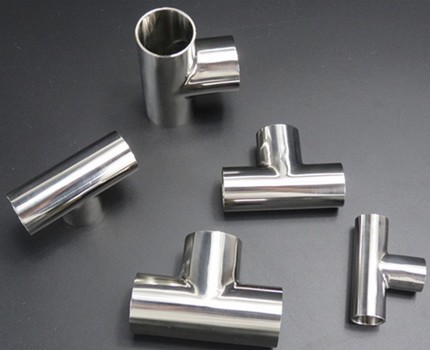
Fittings for welding are used when laying communications that are placed inside structures and do not require replacement of structural elements for a long period.
Due to the complexity of installation, welded fittings are used on pipelines of the oil and gas industry. To create tight joints, the installation is entrusted to qualified specialists working on special equipment.
Screw thread elements
Threaded fittings suitable for joining gas and water steel pipes are produced with a cylindrical screw thread. They are used in the assembly of highways, the temperature regime of the transported liquid of which does not exceed + 175 ° C. Typically, this type of connection is chosen for pipelines with a diameter of up to 50 mm.

Stainless steel alloy threaded fittings are widely used in the construction, chemical, oil and gas industries. But they found the main application precisely in the arrangement of water supply networks and heating systems.
Among novice craftsmen and lay plumbers, a simple-to-use connection method, referred to as an "American", is widely popular. It received its name in honor of the country in which it was patented. The main elements of such a connection are the body and the union nut.
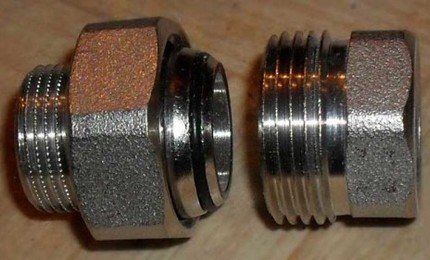
One of the halves of the “American” is screwed onto the short thread of the first pipe, and the second onto the return pipe. Then, both halves are twisted using the union nut worn on the fitting. A high degree of sealing is achieved by a sealant.But to improve it, many masters still "in the old fashion" lay linen fibers.
Features of Crimp Couplings
Pipes can be reliably connected without welding and threading by installing crimp fittings. They are available with one or two o-rings made of flexible flexible materials. Mostly they are used when necessary, matching the elements of the pipeline having the same diameter.
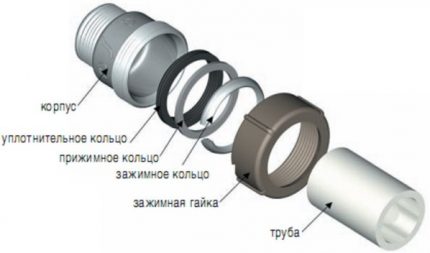
The design of crimp elements for steel pipelines is practically no different from pipe fittings or "brothers" of polymers.
It includes three main elements:
- housing;
- clamping ring and clamping nut
- sealing ring.
The principle of connecting pipe sections by means of crimp fittings is based on the fact that the o-ring and rubber gasket are tight against the surface by pressing the union nut. The crimp ring is tightened using a manual or automatic press.
When connecting pipes by installing crimp fittings, a deviation from the axis of up to three degrees is allowed.

In terms of mechanical strength, the crimp method loses somewhat to the same welded or threaded connection. To tear the pipe out of the unit, it is enough to make a little physical effort.
For this reason, crimp fittings are rarely used in the construction of pipelines designed to transport hot water.
The elastic O-ring included in the package of crimp fittings is designed for temperatures within 100 ° C. With prolonged exposure to hot temperature, rubber loses its properties. As a result, the tightness of the connection is broken.
Although crimp fittings are among the collapsible systems, but in the event of failure of one of the structural elements, the entire unit has to be replaced.
Flange Fittings Design
The flange connection is not inferior in strength and durability. For this reason, it is successfully used in the installation of systems that transport aggressive media under high pressure.
In household communications - water supply and heating systems - it is used quite rarely. This is due to the fact that the thickness of the pipeline increased due to the large diameter of the flange becomes inconvenient in terms of installation and unattractive in terms of aesthetics.
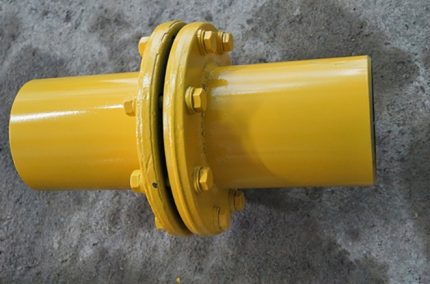
The fittings kit includes:
- paired discs;
- nuts with bolts for tightening the planes;
- gasket made of rubber, graphite or paronite.
The number and size of bolt holes of flange connections is determined by the manufacturer in accordance with GOST. The fastening of the reinforcement itself to the pipe is most often carried out by welding or with the help of a thread applied to the inner surface of the flange.
If you compare these types, the most widely used crimp and threaded fittings. The secret of such popularity lies in the ability to create airtight joints, as well as to re-dismantle products in order to reuse them.
In addition, the installation of such removable elements is easier and faster than in welded joints.
Thread Mounting Technology
Installing a steel fitting on a pipe is no big deal. For example, consider the installation technology of a threaded type coupling.
A set of tools required for work:
- pipe cutter for steel pipes;
- gas and adjustable wrenches;
- manual screwdriver equipped with a holder;
- sealing material.
To increase the tightness of the threaded connection of pipelines intended for transporting cold and hot water, flax strand impregnated with minium or FUM tape is used.
For trunk with a coolant whose temperature is above 100 ° C, a linen strand impregnated with graphite, interwoven with an asbestos cord, is used as a sealant.
The installation process includes a number of basic steps:
- The pipe is clamped in a clip. The ends are pretreated with drying oil, a thread is cut.
- Sealing material is wound in a thin layer along the thread.
- At the end of the first pipe, pre-treated with drying oil or oil paint, screw the sleeve until it is jammed on the run.
- Dock the end of the second pipe, wrapped in the same way, twisting the second branch of the coupling to jam on the run.
The clutch is first twisted by hand, and then reinforced with a pipe wrench. The result is a connection in which the ends of the pipes screwed into the sleeve meet but do not abut against each other.
After completion of the repair work, it remains only to check the quality of the connections. To do this, open the tap and fill the system. If leaks are detected at the connection, tighten the locknuts. If the applied efforts did not give the desired result, it is better to reinstall the connection.
Subtleties of installing a crimp coupling
In a situation where the thread on the pipe has rotted, and it is not practical to cut it, installing a crimp sleeve will be a universal solution.
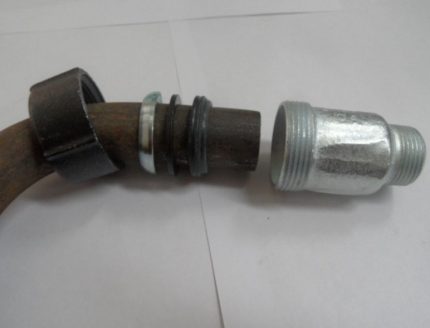
To correctly install the crimp fitting, installation is performed in the following order:
- The pipe section to be joined is cleaned of burrs, processing both the outer surface of the product and the inner one.
- The end of the pipe is inserted into the fitting body, positioning it so that the central part of the coupling strictly matches the joint.
- A crimp ring is pulled onto the pipe.
- A crimp nut is put on the resulting segment. Moving along the thread, the nut will press the crimp ring into the pipe, creating a tight connection.
Do not use excessive force when tightening the nut. Otherwise, the nut will transfer the connection or simply burst.
Conclusions and useful video on the topic
Installation procedure using a threaded sleeve:
Threadless Docking Technology:
We have described the basic methods for joining steel pipes by installing fittings. The best option should be chosen based on the conditions of a particular situation.
Do you have personal experience in assembling steel piping using fittings? Want to share your knowledge or ask questions about the topic? Please leave comments and participate in discussions - the feedback form is located below.

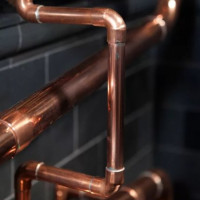 Copper pipes and fittings: types, marking, features of the arrangement of a copper pipeline
Copper pipes and fittings: types, marking, features of the arrangement of a copper pipeline 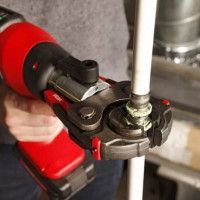 Fittings for plastic pipes: types, applications, an overview of the best manufacturers
Fittings for plastic pipes: types, applications, an overview of the best manufacturers 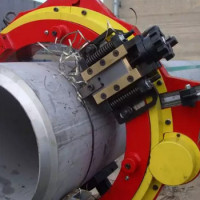 Pipe cutter for steel pipes: types, tips for choosing a model and the nuances of competent operation
Pipe cutter for steel pipes: types, tips for choosing a model and the nuances of competent operation 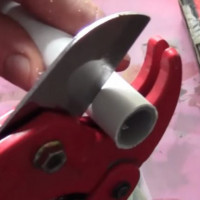 Pipe cutter for plastic pipes: types, which is better to choose and how to use it correctly
Pipe cutter for plastic pipes: types, which is better to choose and how to use it correctly 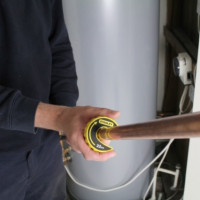 Pipe cutter for copper pipes: types, selection tips, rules and nuances of use
Pipe cutter for copper pipes: types, selection tips, rules and nuances of use 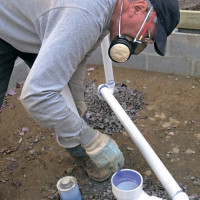 Glue for PVC pipes: an overview of the best compositions and instructions for use
Glue for PVC pipes: an overview of the best compositions and instructions for use  How much does it cost to connect gas to a private house: the price of organizing gas supply
How much does it cost to connect gas to a private house: the price of organizing gas supply  The best washing machines with dryer: model rating and customer tips
The best washing machines with dryer: model rating and customer tips  What is the color temperature of light and the nuances of choosing the temperature of the lamps to suit your needs
What is the color temperature of light and the nuances of choosing the temperature of the lamps to suit your needs  Replacement of a geyser in an apartment: replacement paperwork + basic norms and requirements
Replacement of a geyser in an apartment: replacement paperwork + basic norms and requirements
That's about flax with a meerk - this is probably already superfluous. Yes. it may well be combined, but this is the last century. Like a black cloth tape.
Do not touch the holy !!! As well as the words of the plumber- “I'll do it all right now !!!” And dissolution in the sunset))).
Himself a mechanic of the 8th category, he always wondered at the crucifix @ #! To the community and fucking # @ ism among the “pissing” technicians.
Obsolete or not, but FUM tape and linen strand with minium are still in the recommendations of SNiP 3.05.01-85 as a sealant for threaded connections. Although, of course, the new sealants almost replaced all of this.